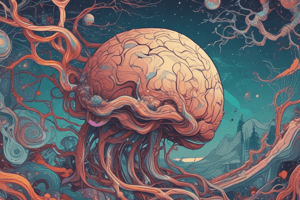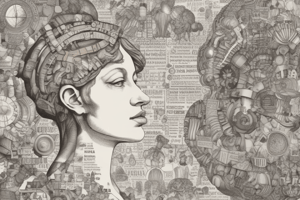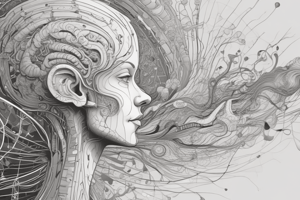Podcast
Questions and Answers
What is the primary function of the Ascending Reticular Activating System (ARAS) in the brain?
What is the primary function of the Ascending Reticular Activating System (ARAS) in the brain?
- To facilitate phonological processing
- To set the level of consciousness and trigger the entire cortex to function (correct)
- To store remote memories
- To process semantic information
Which region of the brain is responsible for determining whether a sound is a word or not?
Which region of the brain is responsible for determining whether a sound is a word or not?
- Medial temporal lobe
- Inferior frontal gyrus (correct)
- Thalamus
- Cerebellum
What is the primary difference between recent memory and remote memory?
What is the primary difference between recent memory and remote memory?
- The strength of the memory, with recent memory being stronger and remote memory being weaker
- The brain region involved, with recent memory involving the thalamus and remote memory involving the hippocampus
- The type of information stored, with recent memory storing visual information and remote memory storing auditory information
- Duration of storage, with recent memory lasting minutes to days and remote memory lasting months to years (correct)
What is the term for the network of neurons involved in setting the level of consciousness?
What is the term for the network of neurons involved in setting the level of consciousness?
Which structure is responsible for rating the emotional importance of an experience and activating the level of hippocampal activity accordingly?
Which structure is responsible for rating the emotional importance of an experience and activating the level of hippocampal activity accordingly?
What is the primary function of the hippocampus in the brain?
What is the primary function of the hippocampus in the brain?
What is the outcome of damage to the amygdala?
What is the outcome of damage to the amygdala?
What is the term for the ability to maintain attention and focus?
What is the term for the ability to maintain attention and focus?
Which cortical area is associated with the regulation of emotions such as affection, pride, guilt, and envy?
Which cortical area is associated with the regulation of emotions such as affection, pride, guilt, and envy?
What is the brain region that is critically involved in the formation of memory?
What is the brain region that is critically involved in the formation of memory?
What is the function of the Papez Circuit?
What is the function of the Papez Circuit?
What is the term for the experience of feeling like a current situation has already occurred before?
What is the term for the experience of feeling like a current situation has already occurred before?
Which structure is implicated in disorders such as schizophrenia?
Which structure is implicated in disorders such as schizophrenia?
What is the effect of stimulation of the subcortical area involving the limbic system?
What is the effect of stimulation of the subcortical area involving the limbic system?
Which area is activated to lift the mood?
Which area is activated to lift the mood?
What is the outcome of a seizure focus within the left prefrontal cortex?
What is the outcome of a seizure focus within the left prefrontal cortex?
Flashcards are hidden until you start studying
Study Notes
Language Comprehension
- Language comprehension involves three levels: phonological, lexical, and semantic processing
- Phonological processing occurs in the inferior gyrus of the frontal lobe, recognizing sounds of vowels and consonants
- Lexical processing matches input words/sounds to memories, determining whether a sound is a word or not
- Semantic processing connects words to their meaning, requiring at least three regions of the brain: brainstem's ARAS, thalamus, and cortex
Localization of Brain Functions
- Arousal and attention require synchronization, with higher levels of wakefulness corresponding to greater synchronization
- In persistent vegetative state, bilateral cortical dysfunction is evident, but sleep-wake cycles may be preserved due to intact thalamus and ARAS
- Maintenance of attention requires an intact right frontal lobe
- In ADHD, frontal lobe or right hemisphere hypometabolism is evident compared to normal controls
Memory
- Memory is critically formed by medial temporal lobe, diencephalic nuclei, and basal forebrain
- Types of memory include:
- Immediate memory (functions over seconds)
- Recent memory (minutes to days)
- Remote memory (months to years)
- Working memory (incorporates immediate and recent memory)
- Medial temporal lobe houses the hippocampus, a significant site for formation and storage of immediate and recent memories
- Hippocampus is inappropriately reactivated with déjà vu experiences
Emotion
- Emotions occupy the attention of mental health professionals
- Emotions are derived from basic drives such as feeding, sex, reproduction, pleasure, pain, fear, and aggression
- Neuroanatomic basis for these drives appears to be centered in the limbic system
- Distinctly human emotions such as affection, pride, guilt, pity, envy, and resentment are largely learned and represented in the cortex
- Left prefrontal cortex activation lifts mood, while right prefrontal cortex activation causes depression
- Left prefrontal hypoperfusion during depressive states normalizes after successful treatment
Limbic System
- The limbic system was delineated by James Papez in 1937
- The Papez circuit consists of hippocampus, fornix, mammillary bodies, anterior nucleus of thalamus, and cingulate gyrus
- The limbic system was eventually expanded to include amygdala, septum, basal forebrain, nucleus accumbens, and orbitofrontal cortex
- The limbic system appears to house emotional association areas, directing the hypothalamus to express motor and endocrine components of emotional states
- Amygdala may mediate learned fear responses, such as anxiety and panic, and direct the expression of certain emotions
- Damage to amygdala abolishes the ability to distinguish fear and anger in other persons' voices and facial expressions
Limbic System Function
- Fear and aggression are stimulated by the subcortical area involving the limbic system, producing rage reactions
- The limbic system is implicated in disorders like schizophrenia
Studying That Suits You
Use AI to generate personalized quizzes and flashcards to suit your learning preferences.




